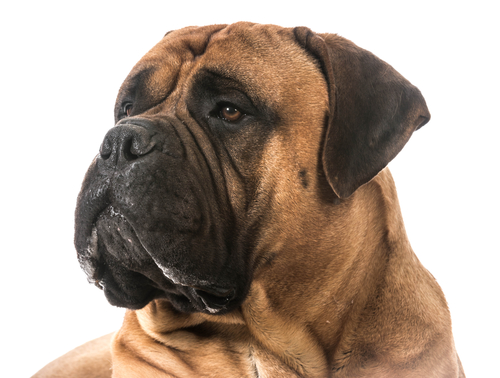
There are other words in the first two sentences of the Bullmastiff standard, but we think three of them are hugely important: “Strength” and “powerfully built.”
Bigger is not better, but brawn is crucial in a breed that was essentially a battering ram. In football parlance, think of the Bullmastiff as a linebacker, or even a fullback, typically the player who lead-blocks for the tailback on running plays. While shoulders are often used to block an opponent, the “heads-up block” is the most common block in football, and not for nothing are these football players immense human beings with thick necks. Indeed, while he was playing, Takeo Spikes, a linebacker in the NFL, had a 20 inch neck that was bigger than his skull, and thicker than some people’s waists.
A large skull… and a very muscular neck that is almost equal in circumference to the skull. You’d think the sentence we just wrote in boldface was written in reference to Takeo Spikes, but in fact, it comes from the Bullmastiff breed standard minus three words. The full sentence is: “A large skull, a broad muzzle, and a very muscular neck that is almost equal in circumference to the skull (we didn’t suppose Takeo Spikes had a muzzle).
By now you’ve got the idea. The Bullmastiff is strong, has a large skull and muscular neck. And it has those features for a reason; the Bullmastiff was “designed” to apprehend and hold a poacher (a capital offense in those days) for however long it took for his or her master, the gamekeeper, to get the situation under control. A pencil-necked dog would not have been up to the challenge.
A neck that was too short would have likely been the result of straight shoulders, certainly no help in catching up to a poacher highly motivated to scram. A neck that was too long would have weakened the neck and impacted the dog’s proportions. As unpleasant as it is to think about, a poacher was going to do whatever it took to get a dog off of himself, and that surely involved leveling blows at the dog’s head. It took a big skull and broad muzzle to withstand the punches of a man fighting, quite literally, for his life.
If you’ll notice the dog’s ears in the photo, they’re not that big, and for good reason. Why give an opponent something to grab onto? Notice, too, the nostrils. They’re open and tilted up to enable the dog to breathe while holding on to writhing, punching body of fearful rage.
There is so much “form following function” in this breed, and that’s just from the neck up.
Image: DepositPhoto
